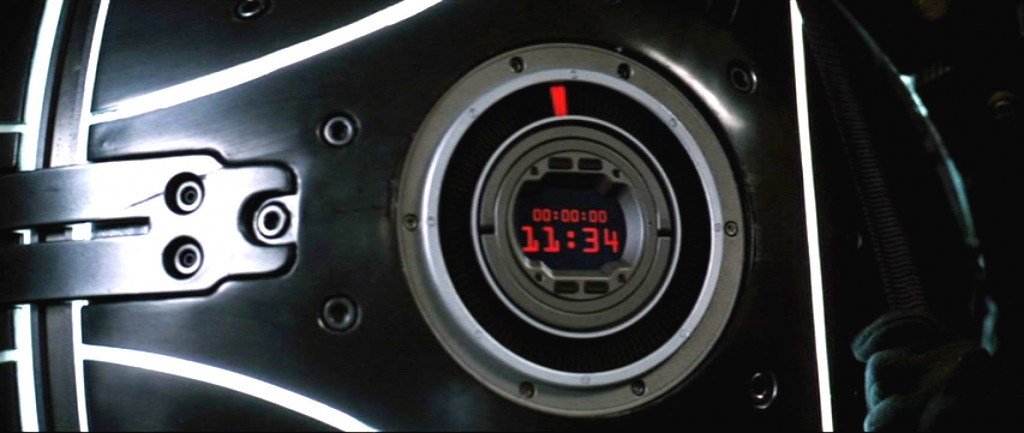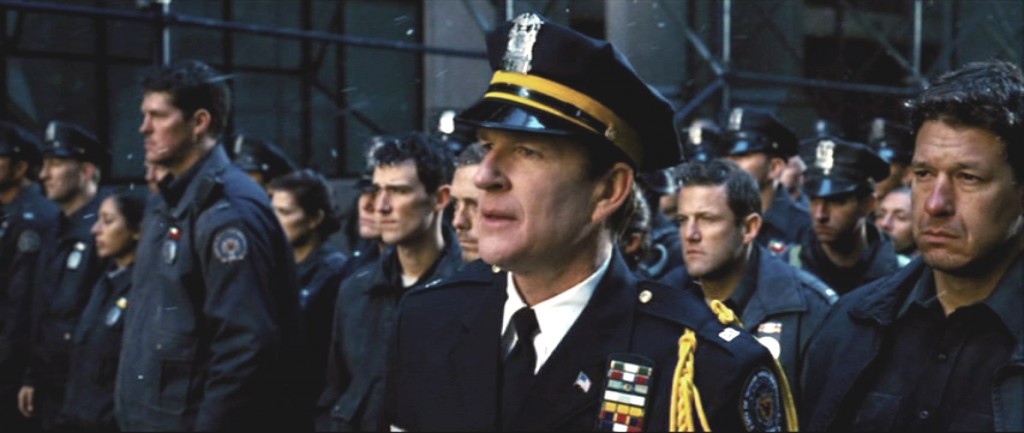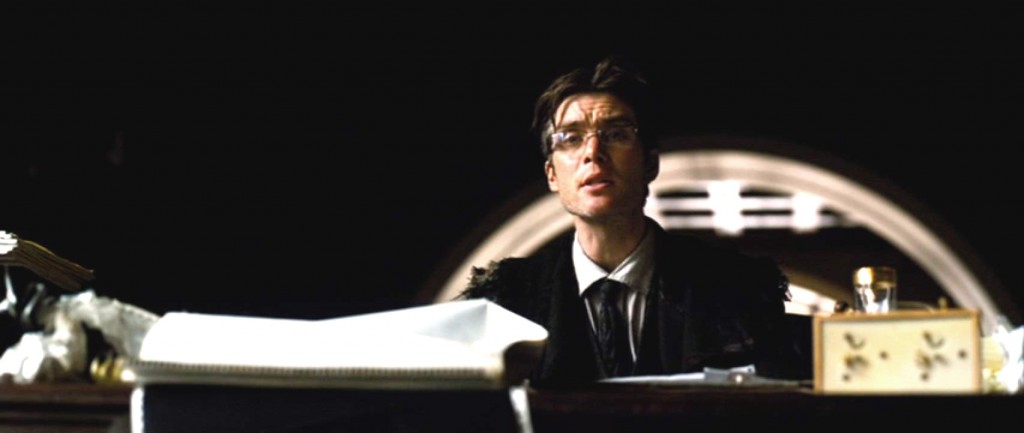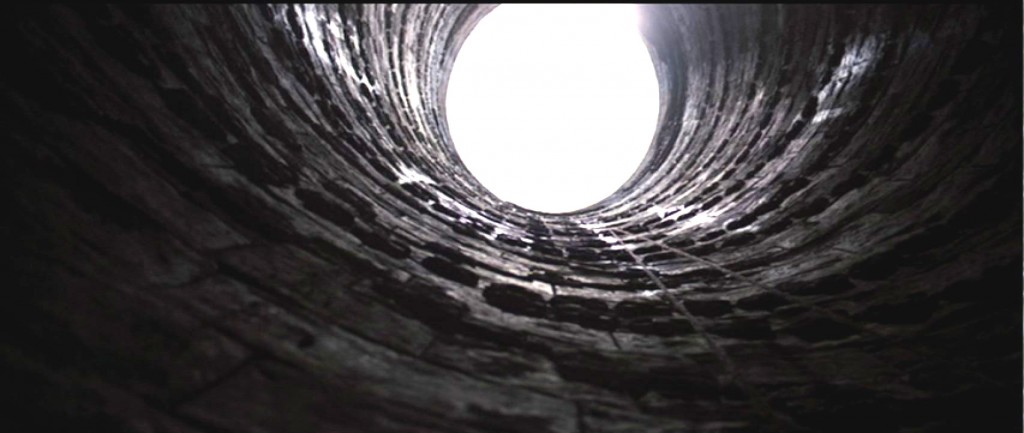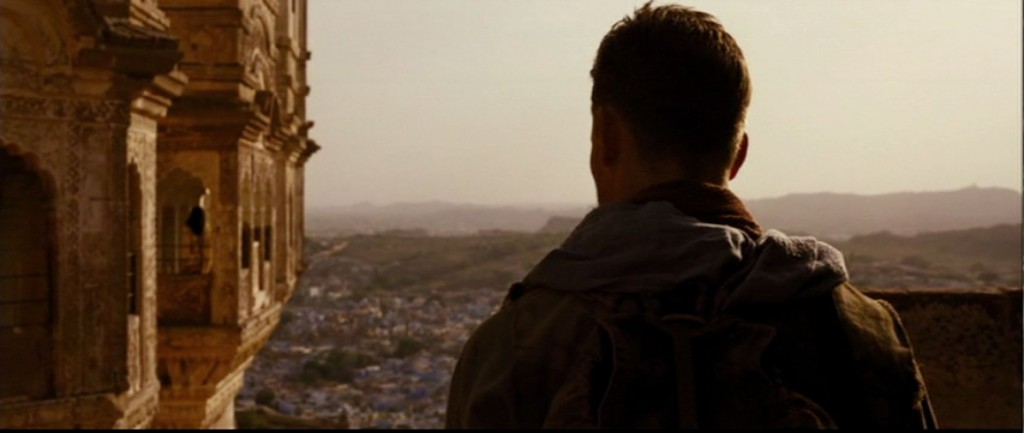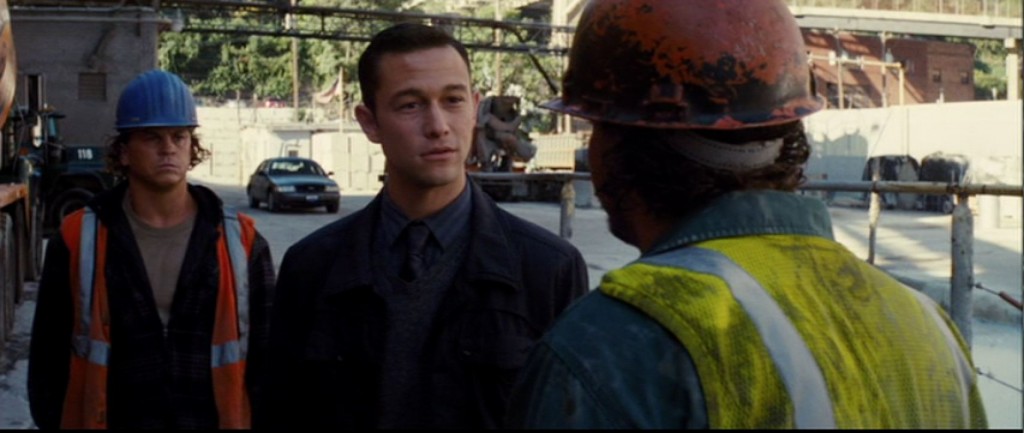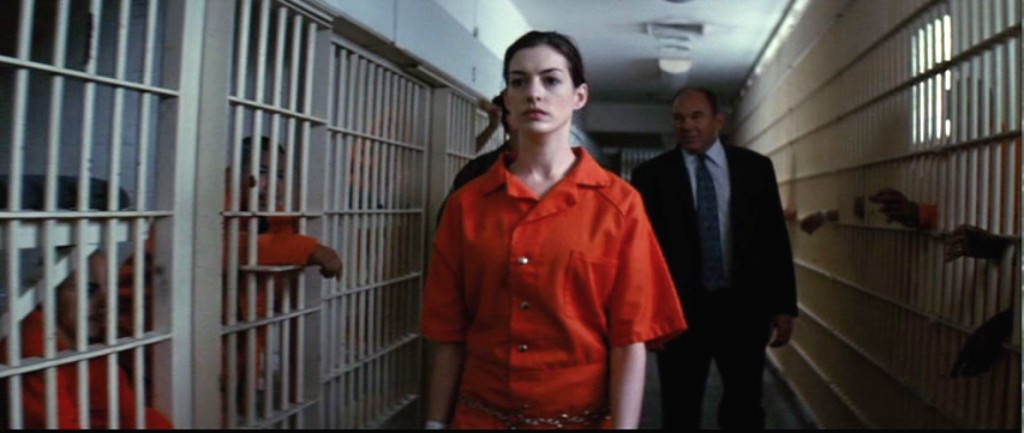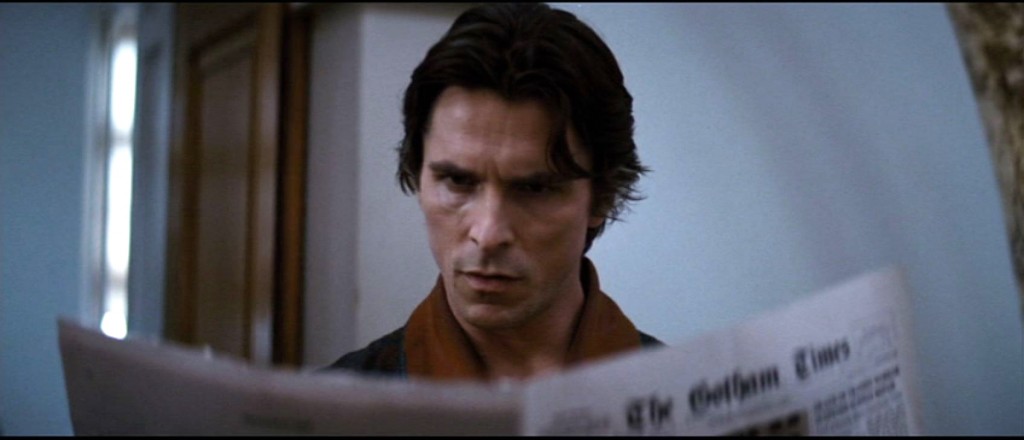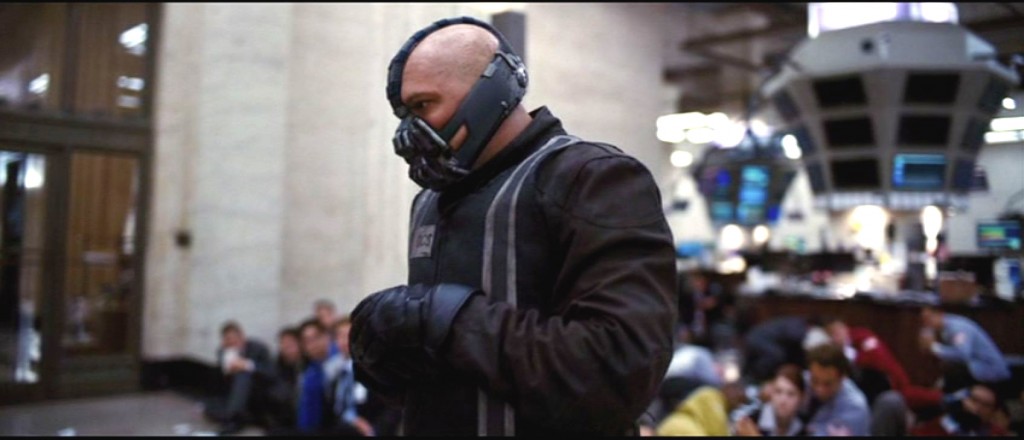Batman on the Big Screen
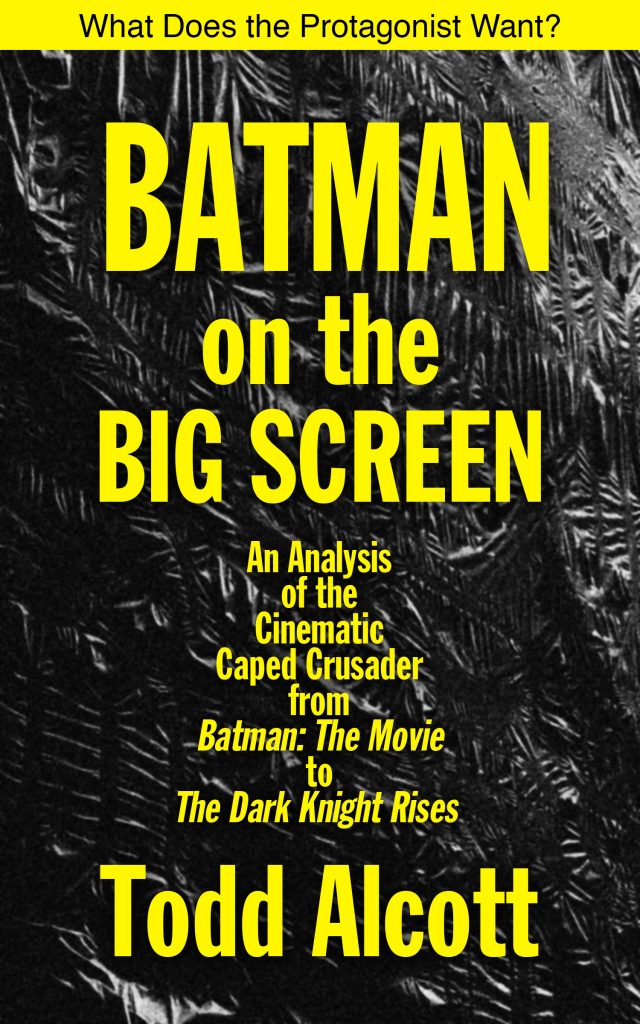
Batman on the Big Screen, a volume collecting everything I’ve written about the Caped Crusader, is now for sale at Amazon. It’s the first in what will be a long line of volumes under the What Does The Protagonist Want? banner. Having just finished editing it, I can tell you, it’s still highly addictive reading!
Batman: The Dark Knight Rises part 15
So, in eleven minutes, Gotham City is going to blow up. A lot can happen in eleven minutes, in a movie, when a nuclear explosion is imminent.
First, we have Blake leading the orphans (and some other citizens) on an exodus out of the city. Depending on where they are in relationship to the bomb, they’ll all die in the explosion regardless of whether they get across the bridge or not, but let’s say that somehow crossing the bridge will magically get them out of harm’s way. Blake gets them halfway across the bridge and runs into another police force (Newark?), whose job it is to keep people from trying to escape (for the public good). As at the top of the sequence, it’s a confrontation between civilians and police, but the positions are reversed. No civilians were in the fight against Bane’s army, because they’re all here with Blake confronting another police force. (The police, don’t forget, are the “thin blue line” separating civilians from criminals — it’s their job to confront thugs, they’re urban warriors. It’s appropriate that the police don’t enlist civilian aide in their attack on Bane’s HQ, just as it seem garishly inappropriate for a police force to threaten to fire upon civilians whose only crime is to wish to escape a nuclear blast.)
Batman: The Dark Knight Rises part 14
As The Dark Knight Rises heads into its final long, sustained suspense-action sequence, it pauses to give a moment of truth to Foley, its most lily-livered character. Foley, who, just yesterday, was seen scurrying into the darkness of his home to avoid confrontation, is now leading an army of cops (freed by Blake and Batman) into an all-out assault on Bane’s headquarters. It seems that, after all, Gordon and Blake have finally inspired Foley, even Foley, to action, to take back his city. For, the question rises, to whom does a city belong? It belongs to its citizens. The Bruce Waynes of the world may think it belongs to themselves, and the politicians may think it belongs to themselves, but a city without citizens is nothing — society is the responsibility of everyone.
Bane’s forces, bless their hearts, give the cops warning before firing. How odd, that they have rules of engagement at this point, against men they entombed months earlier! The beat is meant, of course, to show the complete inversion of roles: the police are now the brave dissidents heading into confrontation with the now de facto criminal police state, ensconced in the corridors of power, complete with Attic Revival Greek temple style white-stone columned buildings. Whatever his pretensions, Bane is the new boss, same as the old boss, but with sharper fangs.
Batman: The Dark Knight Rises part 13
As Act V of The Dark Knight Rises begins, we find Dr. Crane, the Scarecrow, presiding over a kangaroo court, passing judgment on Daggett’s lapdog Stryver, the man who stood by while Bane murdered his boss. Crane sentences him to exile, which, in this case, means death, since exile involves walking across the ice that surrounds Gotham (a city taking its “frozen” status literally). Politically, the scene indicates that Bane’s rule has reached its “terror” phase, where, after all the aristocrats have been purged from the society, the mob turns on itself. “I’m one of you!” splutters Stryver as he’s dragged in. What he means is “I betrayed my master just like you!” but Crane, deep in his insanity, sees Stryver as a leech (the opposite, in fact, of a “striver”). Stryver, and others exiles, teeter out onto the ice, fall through, and drown, again, a literal reminder of the “thin ice” all the moneyed of society walk on.
Batman: The Dark Knight Rises part 12
Bruce is no longer broken but he is still in the pit. “Prisoner,” the only English-speaking guy in the place, warns him against escape, although everyone else in the pit seems really excited about it, they become a positive choir of helpful animals as he climbs the wall. (I still don’t know why he doesn’t pull the rope up after himself, tie a hook to it and use it as a grapple — where is Batman when you need him?) (However, major props to Bruce for taking a major fall with a rope tied around his waist after suffering a broken back.)
When pressed, Prisoner reveals an ooch more about the love-child of the mercenary and the warlord’s daughter — the child, he says, was “no ordinary child, a child born in Hell.” Bruce, he says, is not qualified to escape from the pit, he is a child of privilege, born in the light. Prisoner does not know, perhaps, that falling down a hole is old news to Bruce, although, to be fair, he was rescued from that original hole by his wealthy father. (I’m a little more concerned that Bane claims to have been “born in darkness,” since, as the reader must know by now, Bane is not the child of the pit. Was he, too, born in the pit?)
Batman: The Dark Knight Rises part 11
While Bane’s army pillages Gotham City, Broken Bruce Wayne, in the pit on the other side of the world, is given some rough-hewn physical therapy and told the legend of the child born in the pit. Actually he is told two stories, one about the mercenary who falls in love with the warlord’s daughter, and another about the child of that union, the warlord’s daughter’s child, which is the child born in the pit. We have been told earlier that Bane was born in the pit, and so we latch on to that factoid, because Bane is super-weird, with his accent and his mask and his rage, so we want to know who that guy is. The Dark Knight honored tradition by keeping the identity of the Joker a complete mystery, but Rises is happy to give us a background for its bad guy — even though, we will find out, not the bad guy we’re thinking about.
So Bane, the story will have us believe, is the product of the union of a mercenary and a princess — true love, no doubt, true love punished by a cruel father in a harsh, fairy-tale land with an open-pit prison. A mercenary, by definition, has no dog in a fight, owes no one allegience, but Bane has been perfectly clear about his allegience to Ra’s Al Ghul, a man he thinks of as his spiritual father.
Batman: The Dark Knight Rises part 10
John Blake, new detective, Daytime Batman, is trying to solve the murder of John Daggett. To solve the murder of John Daggett, he’s chasing down leads in construction jobs because of a number of odd construction permits Daggett applied for before his death. If I’m not mistaken, this is not only the most mundane piece of detective work done in The Dark Knight Rises, it is the only detective work done. All of Batman’s detective work in the narrative consists of “getting told things by people.” The Dark Knight had him create his own high-tech ballistic range in his basement so that could find a fingerprint on a shattered bullet, but Rises has him not even bothering to check the background of Miranda Tate before handing over control of his company to her.
Blake asks a couple of construction workers about their work with Daggett, and recognizes one from the stock-exchange heist. A scuffle ensues, leading to Blake accidentally shooting his suspect to death. Blake is greatly upset by this shooting death, but it doesn’t prevent him from first interrogating his suspect in prime Batman style, grabbing the man by the lapels and screaming in his face. So already Blake has taken a step towards Batman-hood, he’s traumatized by a shooting death (except this time he’s the shooter, and not a mugger but a detective) and he’s a brutal interrogator. He also learns that a huge bomb has been constructed, too late to stop the entire police force from stepping into a trap.
Batman: The Dark Knight Rises part 9
Act IV of The Dark Knight Rises begins by checking in with Selina, who is being held at Blackgate Prison for kidnapping the congressman back in Act I. The screenplay takes care to note that Selina, despite her seeming vulnerability amidst a population of convicted criminals, can take care of herself in the worst of circumstances. The script presents this as a physical gag, but it’s important to keep in mind that Selina, as an anti-Batman (and anti-Bruce) (they’re both in prisons at this point), is still at her physical peak compared to Bruce. Bruce is in prison at Bane’s hand, but Selina is in hers by her own hand. One could ask if either character “deserves” his or her imprisonment, and do well to do so, it’s kind of the question of the moment as the narrative moves forward. “Deserves” is that most moveable of moral ends, especially in regards to crime and punishment, and it exists always in relation to its society. Does Bruce “deserve” to lie, broken, in a foreign prison while Bane plots to destroy his own city with the fruits of his own wealth? How many men lie in Blackgate on this day as a result of Bruce’s actions, and how many of them consider themselves innocent or misunderstood? Does Selina “deserve” to be in prison, when she has hurt no one who couldn’t afford it, and only wants to get by in a society that won’t let her forget her past? (Fantine! Although Selina has it much better than Fantine, she doesn’t have to cut her hair, pull her teeth or die of tuberculosis, and she’s developed keen fighting skills to deal with the men who might brutalize her.) “The Dent Act” is mentioned as covering a woman placed in Blackgate (why Selina is in a prison instead of a jail, when she has been convicted of nothing, is another question), and we are meant to understand that the Dent Act has been perhaps overreaching in its efforts to clean up Gotham, which raises all kinds of uncomfortable questions of the authority we grant to the police (and the army) to deal with the people we don’t want to deal with. The Thin Blue Line, we remember, exists primarily to keep property in the hands that have it. Possession is nine-tenths of the law, the police are attack dogs of the possessors. (Funny how the wealthiest wish to avoid paying taxes to the government that keeps their wealth safe and growing.)
Batman: The Dark Knight Rises part 7
Lucius Fox comes to Bruce’s now-Alfredless house to deliver the bad news: Bane’s hit on the stock exchange, where he used Bruce’s Selina-stolen thumbprint to approve some very bad stock buys, has left Bruce broke. (Comics readers know that Bane, historically, “broke” Batman physically — his punishment for Bruce Wayne is more fitting. You break Batman physically, you break a billionaire financially.) (Note that “billionaire playboy” is no longer Bruce’s job description, but rather “billionaire recluse.”) Broke Bruce means that John Daggett can now take over Wayne Enterprises, which means that he has control over the “save the world” project, unless Bruce can put seeming good-guy Miranda Tate in charge of the company.
Batman: The Dark Knight Rises part 6
One bright day, Bane and his minions take over the Gotham City Stock Exchange. Let’s break this down.
